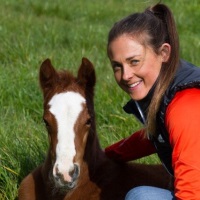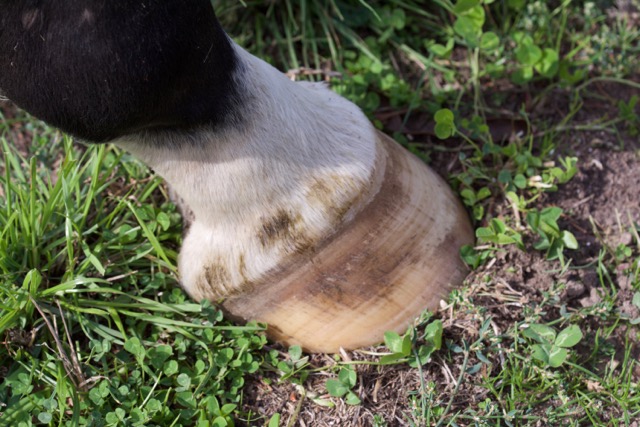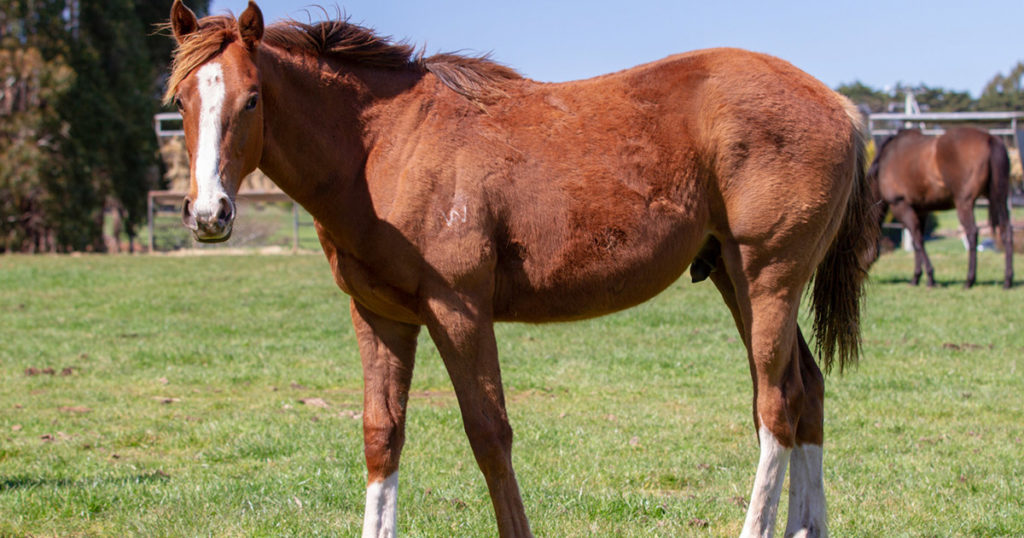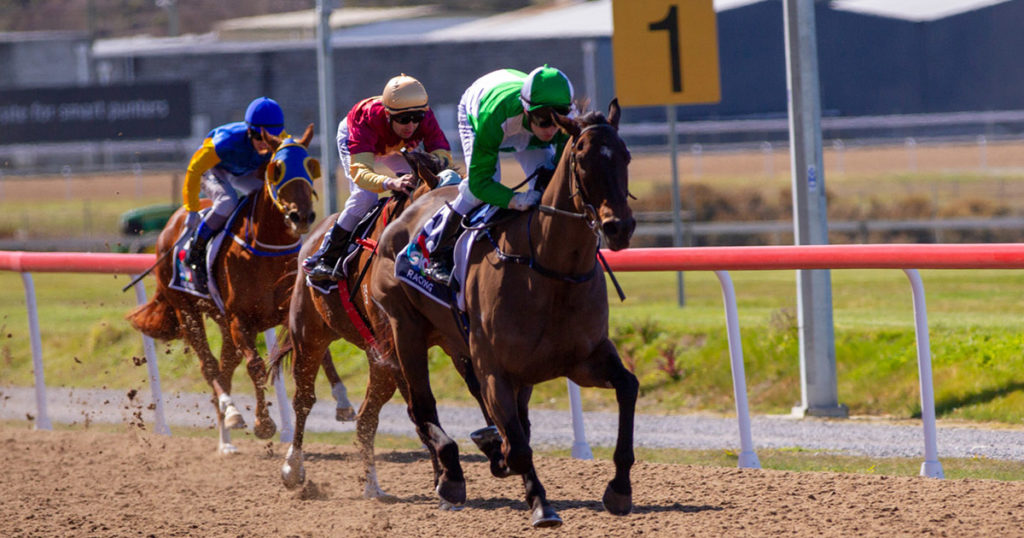What is laminitis?
Laminitis is a painful, often devastating inflammatory condition affecting the lamellar tissue of the foot. Each hoof contains 550-600 primary laminae, and each of those consists of 150-200 secondary laminae. The laminae connect the hoof wall to the coffin bone and function to provide shock absorption during locomotion, holding the coffin bone in place and supporting the horse’s entire body weight against gravity during movement. Laminitis results in the separation or failure of the laminae, causing permanent structural changes in a horse’s foot, leading to repeated bouts of the condition and lasting lameness. In severe cases the pedal (coffin) bone in the hoof can rotate and/or sink downward. This can result in the coffin bone protruding through the sole.
Types
Laminitis can be categorised into 3 types:
- Subclinical (not yet showing clinical signs, but changes have already occurred within the hoof);
- Acute (rapid onset with a short but severe course);
- Chronic (lasting a long period of time or marked by frequent recurrence).
Signs and Symptoms
Laminitis most frequently occurs in the front hooves, which carry the majority of the horse’s weight (about 60%), although it can affect the hind hooves as well.
Common clinical signs include:
- Reluctance or inability to walk;
- Weight-shifting between legs;
- Increased respiratory rate and frequently increased heart rate;
- A glazed, painful expression;
- When front feet are affected, a stance with the hind legs camped under the body and forefeet camped out;
- Bounding (throbbing) digital arterial pulses; and
- Increased heat of the feet (this can be felt by touching the horse’s effected hooves).
Structural damage to the laminae can occur before obvious clinical signs are noticed.
Causes
Laminitis can be caused by several different factors, many of which can overlap or occur concurrently:
- Endocrine disorders. These include Pituitary Pars Intermedia Dysfunction (PPID), the closely associated Equine Cushing’s Disease, and Equine Metabolic Syndrome (EMS). These go hand in hand with pasture-associated laminitis and insulin resistance.
- Nutritionally induced laminitis is another common form of the condition. This primarily occurs through carbohydrate overload. Horses are designed to digest carbohydrates (starches, sugars) in the small intestine and fibre in the hindgut. If the capacity of the small intestine is exceeded however, the digestion of starches and sugars overflows into the hindgut, disrupting the microflora and in turn increasing the acidity of the hindgut. The beneficial microflora die off, creating a toxic environment, damaging the hind gut epithelium and are released into the bloodstream through the now highly permeable epithelium.
- High fructan intake. Fructans are another form of carbohydrate, comprised of fructose and glucose. Horses do not have the enzymes needed to break fructans down so the hindgut bacteria must do this. Fructans are highly fermentable, and if large amounts are consumed it disrupts the hindgut microflora and pH balance.
- Systemic Inflammatory Response Syndrome (SIRS) or toxaemia. This is associated with post-foaling uterine infection/retained placenta, and infectious diarrhoea, among other causes;
- Exposure to black walnut extract, either digested or via contact with hooves, as with bedding;
- Supporting limb laminitis, where one leg is injured and the weight-bearing supporting limb is affected;
- Traumatic laminitis, once called “road founder,” from overuse, often on hard surfaces.
Other less common causes include allergies, infections, fever, cold weather, severe colic cases, hormonal change; drug inducement. All possible causes are worsened by poor hoof care and obesity.
How naturopathy can help laminitis
Naturopathy can help laminitis as part of a holistic treatment approach, in conjunction with proper farriery. Nutritional and herbal medicine, combined with naturopathic management practices can help prevent laminitis; reduce severity, duration and frequency of recurring cases, and help to promote optimal laminae health and hoof growth.
Naturopathic treatment is customised to each individual horse, and therapeutics used are determined by the predisposing cause(s) of laminitis and specific factors pertaining to each case. Discussed below are some of the key treatment aims achieved through naturopathy in cases of laminitis.
Restoring intestinal endothelial integrity and function
One of the keys to reducing the incidence and severity of laminitis is to ensure that the integrity of the intestinal endothelial lining is restored. In the majority of laminitic cases, it is believed that endothelial integrity is compromised and is a key factor in endotoxicity, inflammation, altered gut microbiota and activating metalloproteinases which break down laminae. These factors combined all contribute to laminitis. Endothelial integrity is further exacerbated by the use of anti-inflammatories such as bute, which is commonly used to help manage pain and inflammation in laminitis. Gut membrane integrity can be restored by nutrients such as zinc, vitamin C, B-group vitamins, glutamine and herbs such as Golden Seal, Chamomile and Meadowsweet.
Restoring bowel microflora
Bowel flora is often compromised in cases of laminitis, and often goes hand-in-hand with altered intestinal permeability. This alteration in microflora is likely to contribute to inflammation, increased insulin and blood-glucose levels and obesity as well as being a result of these factors too, thus making it a central mechanism in laminitis. The use of specific pre and probiotics as well as herbs such as Golden Seal, Slippery Elm, Aniseed and Marshmallow Root can help to restore and promote optimal bowel flora.
Reducing inflammation
As discussed earlier, inflammation is a central mechanism in laminitis: both at a local (laminar) level, as well as systemically. It is known that inflammation in the bowel alone can influence systemic inflammatory mediators- thus contributing to and exacerbating laminitis. Herbal and nutritional medicine offer a plethora of natural anti-inflammatories, which are devoid of the side effects common to NSAIDs such as bute- which actually may worsen the pathophysiology of laminitis. Some of the many anti-inflammatories on offer include: Pure fish oil; zinc; Chamomile; Devil’s Claw; White Willow; Meadowsweet; Bilberry; Licorice; Cat’s Claw and Withania.
Reducing Oxidative Stress
Inflammation causes the production of free radicals in the body, and when inflammation is severe and/or chronic (as in the case of laminitis), these free radicals are unable to be eliminated by the body’s natural protective mechanisms (antioxidants) leading to oxidative stress. This increase in oxidative stress leads to further degradation of cells and molecules in the body, and can result in further destruction to the laminae. Naturopathically, we can increase the levels of many different antioxidants in the body, helping to combat free radicals. Nutrients which may be used include: vitamins C and E; minerals such as zinc and selenium; amino acids such as glutamine; and herbs such as Bilberry, Cat’s Claw, Ginkgo, Hawthorn, Rhodiola, Schisandra and St Mary’s Thistle.
Regulating blood flow to the laminae
Alterations in blood flow to the hoof are complex and are believed to vary throughout the progression of laminitis. In the early prodromal and acute phases blood flow to the hoof is thought to increase. As the condition progresses, vascular damage and decreased blood flow in the capillaries is thought to occur, contributing to the further degradation of laminae and poor hoof quality and growth. Herbs such as Ginger, Bilberry, Hawthorn, Gotu, Butcher’s Broom can help to optimise the blood flow and help to maintain vascular integrity, preventing further damage.
Weight management
Weight management is vital in helping to manage laminitis. From a simplistic point of view, the more weight the horse has to carry, the more stress upon the laminae and the hooves. Excess adipose tissue (fat) acts as an endocrine organ: meaning it has an influence on hormone production in the body. It alters peripheral oestrogen levels, promoting and feeding inflammatory mediators and processes. This is also closely associated with high blood glucose levels (which, when sustained leads to blood vessel damage) and high insulin levels and insulin resistance. Naturopathic methods employed to help promote and maintain a healthy weight include nutritional and management advice. Herbs such as Licorice, Bladderwrack, Coleus and Globe Artichoke may be a valuable inclusion, when combined with appropriate management and dietary interventions.
Insulin and blood glucose stabilisation
Insulin is needed to help keep blood glucose levels stable. Carrying excess body fat is one of the primary causes of insulin resistance. In cases of insulin resistance, the body becomes less sensitive to the actions of insulin, leading to high levels of glucose in the bloodstream. This further drives inflammation and oxidation in the body, leading to further damage of the laminae. Nutrition and management practices are fundamental considerations in regulating insulin and blood glucose levels. Cinnamon, Korean Ginseng and St Mary’s Thistle are fantastic herbal additions to aid in insulin sensitivity and regulation. Nutritionally, chromium, magnesium, zinc, vitamin C, vitamin E, selenium, fish oil, vitamin E, coenzyme Q10, acetyl-L-carnitine, B group vitamins, zinc and manganese can all play valuable roles in promoting good blood glucose control and insulin sensitivity.
Hormonal regulation
Horses with PPID/Cushing’s Disease produce insufficient dopamine, which leads to the pituitary gland being unregulated. This in turn results in over-production of the hormone ACTH (amongst others). Up to 70% of horses with PPID are thought to develop laminitis, most likely due to the exaggerated insulin response, which occurs when sugars (such as those naturally found in grass and feeds) are ingested. The herb Vitex is down to bind to and activate dopamine receptors, thereby helping to regulate ACTH levels. Nutritional cofactors essential for dopamine production are also important considerations. These include: Phenylalanine, tyrosine, B group vitamins, vitamin C, magnesium and iron.
Promoting healthy hoof growth
Hoof growth in horses with laminitis can be varied, but is typically faster than horses without laminitis. The heel of laminitic horses often grows faster than the toe (due to changes in blood flow), but the quality of the hoof tends to be poor. In addition to regular specialist farrier care, it is essential to provide the nutrients needed for healthy hoof growth, as well as regulating circulation to the entire hoof through the use of herbal medicine. Biotin, zinc, vitamin C, omega-3 fatty acids, calcium, selenium, manganese and protein (particularly the amino acids methionine, cysteine and lysine) all play crucial roles in healthy hoof growth. Ginger, Hawthorn, Prickly Ash, St Mary’s Thistle, Gotu and Bilberry are all valuable herbal medicines to support optimal hoof health in the laminitic horse.
Promote healthy diet
When treating any equine health condition, the importance of facilitating optimal overall health cannot be forgotten. Treatment plans must take into account meeting each horse’s individual nutritional and therapeutic needs, and not just treating the presenting disease process (in this case laminitis). For this reason, the nutrients and herbs used to treat each horse will vary between individuals.
Stress
Controlling the stress response in the laminitic horse is essential to help prevent further destruction of the laminae, and to help facilitate healing. Stress- whether caused by pain, environmental factors, dietary factors, or the horse’s natural temperament tendencies, all contribute to elevating the hormone cortisol in the body. High cortisol levels: drive inflammation; promote insulin resistance; elevate blood glucose levels; interfere with digestion and nutrient absorption; compromise endothelial integrity and function; disrupt bowel microflora; deplete the body of vital nutrients such as vitamin C, magnesium, B-group vitamins; contribute to elevated levels of oxidative stress; alter hormonal levels; and cause changes in blood flow. The importance of optimising cortisol levels in the laminitic horse can therefore not be underestimated. Depending on the stressors involved and the individual horse, important nutrients to consider include vitamin E, magnesium, specific amino acids, B group vitamins and vitamin C. Herbal medicines used may include Valerian, Chamomile, Withania, Lemon Balm, Corydalis and Vervain.
Conclusion
From the factors discussed above, correctly prescribed naturopathy has a vital role to play in the prevention, treatment and management of laminitis. There are a plethora of effective nutrients and herbs to help achieve specific treatment goals in laminitis, and those employed must be selected to best fit each individual horse. It is paramount to know that specific herbs and nutrients have cautions, contraindications, toxicity levels and interactions between other herbs, nutrients and conventional pharmaceuticals. The importance of professional prescribing is therefore essential in order to appropriately select safe and effective therapeutics, achieve treatment goals and facilitate the best possible outcome for each individual horse.

Camilla Whishaw is a highly regarded, experienced horsewoman and naturopath, helping to holistically treat and manage a broad range of equine health conditions and injuries, with a passion for mare and stallion fertility.
As a world-renowned practitioner, presenter, author, and consultant in the field of Equine Naturopathy, Camilla shares her knowledge through keynote presentations, interviews, lectures, panel sessions, and workshop training.





